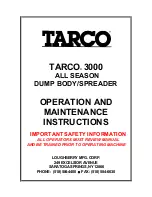
CAB A N D BODY M OUNTINGS 1-28
N O T E : H desired, masking tape can be ap
plied to retain loose parts temporarily in position.
2. Carefully lower the cab to chassis and at
same time engage the steering shaft to gear shaft
using marks made prior to removal for alignment.
Tighten shaft clamp bolt (when used) to 35 to 40
foot-pounds torque or clamp bolt nut (when used)
to 40 to 50 foot-pounds torque.
3. Install balance of cab mounting components.
4. Connect speedometer cable.
5. Connect hand brake if of the mechanical
type.
6. Connect accelerator linkage.
7. Connect all control and gauge lines.
8. Connect fuel line if previously disconnected.
9. Connect heater hoses if used, then fill cool
ing system.
10. Service the hydraulic brake system if used.
11. Service the clutch hydraulic system. Use
new fluid.
12. Connect all electrical wiring.
13. Connect battery cables.
14. Install hood panels.
15. Recheck all connections of wiring, lines,
and control linkage.
16. With wheels blocked as a safety measure,
start engine, then final check all connections and
linkage.
CAB HEATING AND VENTILATION
(CONVENTIONAL CAB MODELS)
HEATERS
Two types of heaters may be used in these
conventional cabs, the standard duty air-flow type
(fig, 30), and the heavy duty air-flow type (fig. 31).
All the heater components are located within cab,
under the dash.
Description, operation, and maintenance in
formation for each type heater is explained under
applicable headings.
Service diagnosis information, covering both
types of heaters, is explained later at end of the
heater section in this group.
STANDARD AIR-FLOW HEATER
The standard air-flow heater provides heated
outside air for heating and defrosting requirements.
Outside air is drawn through the air inlet grille at
right side of cab cowl and through the heater by
the blower motor. The degree of heated air to be
expelled by heater is determined by the position of
! 'O F F -AIR- O N " lever at side of the air distributor.
IMPORTANT
Avoid operating the blower motor with
this control lever in " O F F " position.
The control marked ’’ON - DEFR OST- O FF "
regulates the flow of heated air to either the wind
shield defroster outlets or onto floor, or to both.
The blower motor speed is regulated by the
dash switch aad a resistor unit. Resistor unit is
attached to top of blower shroud with two screws.
If resistor should become defective the result will
be high speed blower motor operation in both the
" M E D I U M " and " L O W " speed switch positions.
HEATER CORE, BLOWER AND
DISTRIBUTOR DUCT REPLACEMENT
(STANDARD AIR-FLOW HEATER)
N O T E : Both the distributor duct and the blow
er assembly can be readily replaced separately
without having to remove the heater core unit from
cab. The replacement procedure below describes
the method for replacing the heater air distributor,
the blower and motor assembly, and the heater
core unit which are all shown in figure 30.
R E M O V A L (Refer to Fig. 30)
1. Drain the cooling system to just below level
of heater core fittings.
2. Mark the heater hoses and piping at front
of cowl for identification purposes later at install
ation, then disconnect hoses.
Figure
3 0 — Standard
Duty Air-Flow Heater
CHEVROLET SERIES 70-80 H EAVY DUTY TRUCK SH O P M A N U A L
Содержание 70 1969 Series
Страница 1: ...CHEVROLET HEAVY DUTY TRUCK SHOP MANUAL...
Страница 3: ......
Страница 11: ...LUBRICATION 0 4 CHEVROLET SERIES 70 80 HEAVY DUTY TRUCK SHOP MANUAL...
Страница 27: ......
Страница 119: ......
Страница 361: ......
Страница 371: ......
Страница 403: ...TROUBLE ANALYSIS CHART ENGINE ELECTRICAL 6Y 32 CHEVROLET SERIES 70 80 HEAVY DUTY TRUCK SHOP MANUAL...
Страница 427: ......
Страница 443: ......
Страница 451: ......
Страница 493: ......
Страница 499: ......
Страница 549: ......
Страница 555: ......
Страница 609: ......
Страница 715: ...am...
Страница 745: ......
Страница 807: ...TRANSMISSION AND CLUTCH 7 61 CHEVROLET SERIES 70 80 HEAVY DUTY TRUCK SHOP M AN U AL Kgure 2 Clark 401 Transmission...
Страница 910: ......
Страница 913: ......






































